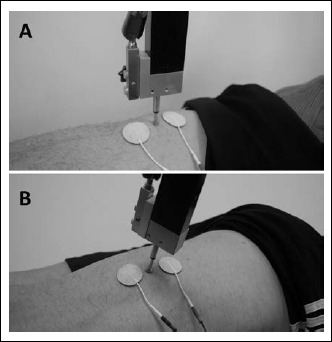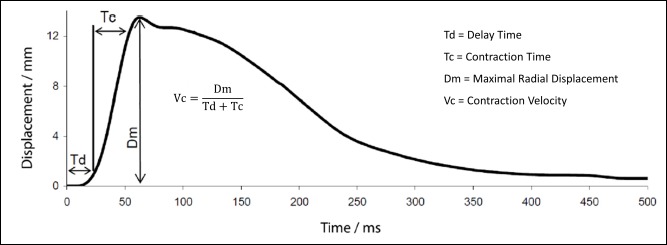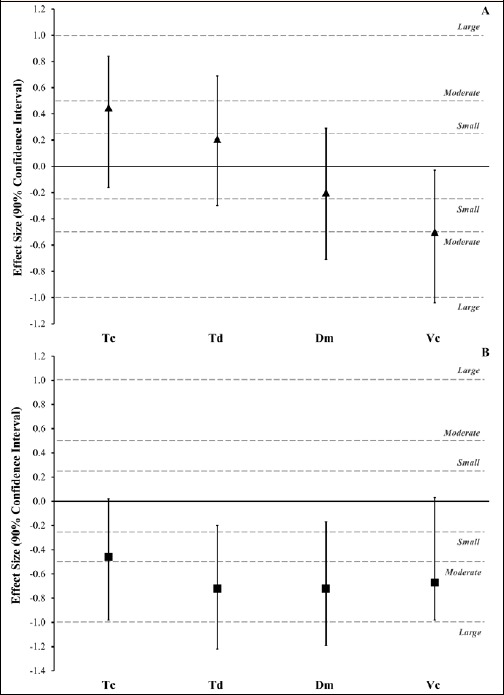Abstract
Tensiomyography (TMG) has been used as a simple and non-invasive tool to assess the mechanical properties of skeletal muscles. The TMG-derived velocity of contraction (Vc), which can be calculated from the ratio between maximal radial displacement and the sum of contraction time and delay time, has been proposed for evaluating athletes. However, its sensitivity to training effects and possible relation with changes in soccer players’ neuromuscular performance have not yet been addressed. To test this possibility, twenty-two male Brazilian elite soccer players were assessed using TMG-derived Vc, unloaded squat jump, countermovement jump and drop jump at 45 cm, loaded jump squat and linear (20 m) and change of direction (COD) sprint tests, prior to and after an 8-week period, between two consecutive official tournaments, during which the concurrency between endurance and strength-power training commonly impairs neuromuscular capacities. Magnitude-based inference was used to detect meaningful training effects. From pre- to post-tests, it was observed likely to almost certainly improvements in all modes of jumping tests. In addition, we could verify decrements in the 20-m and COD sprint performances, which were rated as very likely and almost certainly, respectively. Finally, both rectus femoris and biceps femoris muscles presented a likely reduction in Vc. Therefore, chronic decreases in sprinting speed are possibly accompanied by a reduced TMG-derived Vc. From a practical standpoint, the TMG-derived Vc can be used to monitor negative specific-soccer training effects related to potential impairments in maximum speed.
Key points.
Tensiomyography (TMG) can be considered a useful technology for coaches and sport scientists seeking for non-invasive and practical tools to assess the muscle function of elite athletes;
Velocity of contraction (Vc) is a single index able to integrate several of the reliable mechanical outcomes provided by TMG, which was shown to be sensitive to detect neuromuscular impairments in professional soccer players;
After 8 weeks of specific soccer training, the changes in the Vc seem to occur in the same direction as the reductions in maximal sprint ability and COD speed.
Key words: Football, concurrent training, muscle function, elite athletes, muscle power
Introduction
Neuromuscular abilities play a determinant role in contemporary soccer. Professional players are required to perform progressively greater sprinting distances per match (Barnes et al., 2014), with straight sprints known to be the most frequent action to create opportunities for goal scoring (Faude et al., 2012). Hence, it is a paradox that typical soccer preparation negatively affects the players’ neuromuscular development due to the interference phenomenon between endurance (i.e., technical-tactical sessions) and strength-power training (Faude et al., 2013b; Loturco et al., 2015c; Noon et al., 2015). This phenomenon represents a challenge to the coaching staff that needs to conciliate adequate ball-related training volume – aerobic loading – and preservation of the neuromuscular capacities that support the increasingly high soccer physical match demands (Barnes et al., 2014; Folgado et al., 2014).
Of note, the combination of reduced technical-tactical training volume and adequate neuromuscular stimuli (e.g., plyometrics and jump squat exercises) can produce positive effects on strength-power abilities (Loturco et al., 2015a; 2015d; Ramirez-Campillo et al., 2015). As an example, it was reported that either increasing or decreasing the bar velocity during jump squat training were capable of improving the jumping ability and sprinting speed in soccer players undertaking less than 300 min of accumulated technical-tactical training per week (Loturco et al., 2015a), with the strategy of increasing the bar velocity producing superior adaptations in sprinting speed. Accordingly, “unloaded” plyometric training using vertical and horizontal jumps has been shown to be effective in improving sprinting and jumping abilities during soccer preseasons performed with similarly low technical-tactical training exposure. Furthermore, combining strength and power training during the competitive season was able to improve isometric peak strength and rate of force development, without altering sprinting speed (Faude et al., 2013a). On the other hand, the absence of specific strength-power interventions can impair sprinting speed and isokinetic strength throughout the competitive season (Eniseler et al., 2012; Magal et al., 2009). In summary, the concurrent training effects and/or the detraining of power-speed abilities will result in loss of “sport form” in soccer players, with negative effects on match running locomotor performance (Silva et al., 2013).
In spite of the widely described seasonal changes in the neuromuscular abilities in soccer players, less is known about the mechanical responses of the trained muscles during the course of different training periods and their respective consequences on speed and power performance. In this regard, tensiomyography (TMG) has been used as a simple and non-invasive tool to assess the mechanical properties of skeletal muscles. Several contractile parameters can be derived from the application of this technique, such as the contraction time (Tc), delay time (Td) and maximal radial displacement (Dm). Contraction time (which is obtained by determining the time lapse from 10% to 90% of Dm) has been related to the speed of force generation, while Td is related to the muscle fiber conduction velocity and Dm to the muscle belly stiffness (Simunic et al., 2011; Tous-Fajardo et al., 2010). These indices are highly reproducible (ICC = 0.92 to 0.97; CV = 2.7 to 4.7%) and correlated with physiological and performance characteristics (Tous-Fajardo et al., 2010). For example, Tc presented a correlation of 0.88 with the proportion of myosin heavy chain I of the vastus lateralis muscle (Simunic et al., 2011), whereas Td of the same muscle in sprinters and endurance runners presented a correlation of -0.72 with countermovement jump height (Loturco et al., 2014). Interestingly, a recent study (Garcia-Garcia et al., 2016) involving soccer players showed that, in response to 10 weeks of training, knee extensor muscles presented a 17.7% to 22.7% decrease in Tc, an 8.7% to 9.9% decrease in Td, and a 12.2% to 14.2% decrease in Dm, while there was an 11.9% increase in Td and a 24.5% increase in Dm in the knee flexors. Unfortunately, the investigated players did not execute any performance test. Consequently, it was not possible to link the changes in each of the TMG parameters, measured in the different muscle groups, to specific functional performance changes. In addition, the differences in the magnitude of the percentages and the dissimilarity in the direction of changes observed in each one of the examined contractile parameters have hampered a more integrated and functional view of their prospective neuromuscular adaptations.
Hence, although the TMG-derived measures acceptably represent some “isolated” muscle contractile properties, it is very difficult for sports coaches to correctly interpret and practically implement the outcomes in the athletes’ training routines. One possible way to make the TMG outcomes simpler to use and interpret is by combining them into a single index that integrates several of the meaningful and reliable mechanical outcomes. In this regard, by arranging the TMG variables, the velocity of contraction (Vc) can be calculated as follows: Vc=Dm/(Td+Tc). This index seems to be a practical and useful way to assess the mechanical functionality of the muscles. Some authors have already suggested some indices related to the muscle contraction velocity to properly assess muscle functionality in top-level athletes (Rodríguez-Matoso et al., 2012); however, its sensitivity to training effects (especially in soccer where TMG has been proposed to be useful (Barcelona, 2015)) and possible relation with changes in soccer players’ neuromuscular performance need to be addressed.
Therefore, the aim of this study was twofold: 1) to verify whether professional soccer players express changes in speed-power related abilities and muscle mechanical properties during the an 8-week training period and; 2) to examine the similarities between the direction of these mechanical and performance changes. It was hypothesized that professional soccer players would experience adverse changes in speed-power related abilities [due to concurrent training practices commonly found in soccer (Loturco et al., 2015c; Silva et al., 2013)] and these changes would be accompanied by impairments in muscle mechanical properties (i.e., TMG-derived Vc).
Methods
Participants
Twenty-two male Brazilian elite soccer players (age: 23.8 ± 4.2 years, height: 1.77 ± 0.07 m, body mass: 76.2 ± 8.0 kg) from the same professional soccer team took part in this study. The investigated team had recently finished participating in the most competitive Brazilian regional championship (São Paulo State 1st division) and, at the time of this investigation, was in preparation for the inferior division of the Brazilian National championship. After being informed of the experimental risks, the soccer players signed a written informed consent to participate in this study. The research was approved by the local Ethics Committee.
Study design
This is a repeated measures design study assessing elite soccer players’ jumping and sprinting abilities, along with muscle contraction properties provided by TMG, prior to and after an 8-week training period. This period was implemented in the transition between the State and the National championships. One-week off was provided to allow players time to recover from participation in the State championship. The pre-training tests were performed 24-h prior to the first training session, while the post-training tests were executed 48-h after the final training session. The first competitive match took place 2 weeks following the post-tests. Both pre-tests and post-tests were performed in the following order: 1) TMG measurement; 2) squat jump (SJ), countermovement jump (CMJ), and drop jump (DJ); 3) jump squat (JS); 4) 20-m linear sprint and 5) change of direction (COD) sprint. The TMG indices were assessed with the players not performing any warm-up, as it can bias the muscular contraction mechanical parameters. Prior to testing sessions, a general and specific warm-up routine was performed, involving light running (5-min at a self-selected pace followed by 3-min lower limb active stretching) and submaximal attempts at each testing exercise (e.g., submaximal vertical jumps or sprints). All tests took place in the same sports laboratory and commenced at the same time of day (≈ 9 a.m.) on both occasions. All athletes had been previously familiarized with the tests due to their regular training and testing routines. During the 8 weeks of training, the athletes completed, on average, 8 training sessions per week, which consisted of ≈ 6 technical and tactical (game-based training) and ≈ 2 strength-power (e.g., unloaded vertical and horizontal jumps, and JS) training sessions. Table 1 shows a typical weekly training routine during the respective training period.
Table 1.
Typical weekly training routine during the soccer inter-season.
| Monday | Tuesday | Wednesday | Thursday | Friday | |
|---|---|---|---|---|---|
| Morning | TEC/TAC *90’ | ST/PT *30’ | Rest | ST/PT *30’ | Rest |
| Afternoon | TEC/TAC *70’ | TEC/TAC *90’ | TEC/TAC *120’ | TEC/TAC *80’ | TEC/TAC *90’ |
TEC = technical training; TAC = tactical training; ST/PT = strength-power training.
* Total training-session time
Tensiomyography assessment
The Dm, Tc, Td and Vc were recorded from both the rectus (RF) and biceps femoris (BF) muscles from the dominant leg (Rey et al., 2012), using a Tensiomyography device (TMG Measurement System, TMG-BMC Ltd., Ljubljana, Slovenia) (Figure 1). The Dm corresponds to the radial movement of the muscle belly expressed in millimeters and is related to muscle belly stiffness. The Tc is obtained by determining the time lapse from 10% to 90% of Dm. Td represents the time spent to reach 10% of the total movement after stimulation (Garcia-Manso et al., 2011). TMG-derived Vc was calculated by dividing Dm by the sum of Tc and Td (Figure 2). RF measurements were performed with the athletes in a supine position, using a triangular wedge foam cushion to maintain the legs in a position corresponding to 120° of knee flexion. The sensor was placed at 50% on the line from the anterior spina iliaca superior to the superior part of the patella. For BF measurements, the athletes adopted a prone position, with their knees in full extension. The sensor was placed at 50% on the line between the ischial tuberosity and the lateral epicondyle of the tibia. An accurate pressure transducer (Trans-TekwGK40, Ljubljana, Slovenia) was positioned perpendicular to the muscle axis. The recording of the radial displacement took place in the muscle belly after an external electrical stimulus. To induce the twitch responses, adhesive electrodes 5/5 cm (Compex Medical AS, Ecublens, Switzerland) were connected to an electric stimulator and positioned on the muscle surface, following the arrangement of the fibers. The distance between the measurement point and the electrodes was standardized to between 55 and 60 mm. The electric pulse was set to 1 m.s-1 and the signal amplitude started at 30mA. For each pulse, current amplitude was increased by 10mA, until the maximal displacement of the muscle belly was reached. To avoid fatigue or potentiation effects, a 15 s resting period was allowed between electrical stimuli (Krizaj et al., 2008). The same experienced examiner conducted all the measurements. Coefficients of variation (CV) and intraclass correlation coefficients (ICCs) were used to indicate the absolute and relative reliability of the TMG variables presented in this study. The ICC and the CV varied from 0.92 to 0.97 and from 2.7 to 4.7%, respectively (Tous-Fajardo et al., 2010).
Figure 1.

Tensiomyography assessment in the rectus femoris (A) and biceps femoris (B).
Figure 2.

Mechanical variables obtained during a tensiomyography measurement. The muscle contraction velocity (Vc) calculation is detailed in the figure.
Vertical jump tests
Vertical jump height was determined in the SJ, CMJ and DJ tests. In the SJ, the subjects were required to remain in a static position with a 90° knee flexion angle for 2-s prior to jumping, without any preparatory movement. In the CMJ, the players were instructed to execute a downward movement followed by a complete extension of the legs and were free to determine the countermovement amplitude to avoid changes in jumping coordination. The athletes were instructed to jump as high as possible. In the DJ, the athletes started from boxes of 45 cm (DJ 45) and had to drop, land with both feet at the same time. The jumps were executed with the hands fixed on the hips, and again the participants were required to jump as high as possible. All jumps were performed on a contact mat (Smart Jump; Fusion Sport, Coopers Plains, Australia). A total of five attempts were allowed for each jump. The best SJ, CMJ, and DJ 45 attempts were retained for analysis. The ICC and CV of the SJ and CMJ were 0.96 and 3.1%, and 0.94 and 3.5%, respectively.
System mean propulsive power in the jump squat exercise
Mean propulsive power (MPP) in the JS was assessed on a Smith machine (Hammer Strength, Rosemont, IL, USA). Players were instructed to execute three repetitions at maximal velocity for each load, starting at 40% of their body mass. Athletes executed a knee flexion until the thigh was parallel to the ground (≈ 100° knee angle) and, after a command, jumped as fast as possible without losing contact between their shoulder and the bar. A load of 10% body mass was gradually added in each set until a minimum decrease of at least 5% (between sets) in MPP was observed. A 5-minute interval was provided between sets. To determine MPP, a linear transducer (T-Force, Dynamic Measurement System; Ergotech Consulting S.L., Murcia, Spain) was attached to the Smith machine bar. The technical specification of the MPP calculation and the use of MPP rather than mean power or peak power have been previously described (Loturco et al., 2015b; 2015c; Sanchez-Medina et al., 2010). The maximum MPP, individually obtained in 4-5 sets (on average), was considered for data analysis purposes. In order to consider the changes in body mass across the training period and to avoid misinterpretation of the power outputs, these values were normalized by dividing the absolute power value by the body mass (i.e., relative power = W.kg-1) (MPP REL). The ICC and CV of MPP in the JS were 0.96 and 4.1%, respectively.
Sprint velocity
Four pairs of photocells (Smart Speed, Fusion Equipment, Australia) were positioned at distances of 0, 5, 10 and 20 m along the sprinting course, prior to the execution of the speed tests. The soccer players sprinted twice, starting from a standing position with the rear of the front foot positioned 0.3 m behind the start line. In order to avoid weather influences, the sprint tests were performed on an indoor running track. A 5-min rest interval was allowed between the two attempts and the fastest time was considered for the analyses. The sprinting velocity (VEL) was derived from the time to complete the target distances in order to facilitate its interpretation. The ICC and CV of the VEL 20 m were 0.97 and 2.3%, respectively.
Change of direction speed test
The COD test course consisted of four 5m sections marked with cones set at 100° angles, in an indoor court (Little and Williams, 2005). The athletes were required to decelerate and accelerate as fast as possible without losing body stability. Two maximal attempts were performed with a 5-min rest interval between attempts. Starting from a standing position with the rear of the front foot placed 0.3m behind the first pair of photocells (i.e., starting line), the athletes ran and changed direction as quickly as possible, until crossing the second pair of photocells, placed 20 m from the starting line. The COD speed was derived from the time to complete the target distance. The ICC and CV of the COD speed test were 0.96 and 2.4%, respectively.
Statistical analysis
Data are presented as mean ± standard deviation. To analyse the differences in the TMG measures and in the jump and sprinting performances between pre- and post-tests, magnitude-based inference was used (Batterham and Hopkins, 2006). The quantitative chances of finding differences in the variables tested were assessed qualitatively as follows: <1%, almost certainly not; 1% to 5%, very unlikely; 5% to 25%, unlikely; 25% to 75%, possible; 75% to 95%, likely; 95% to 99%, very likely; >99%, almost certain. If the chances of having better and poorer results were both >5%, the true difference was assessed as unclear. The magnitudes of the differences between pre- and post-tests for all variables were analysed using the Cohen’s d effect size (ES) (Cohen, 1988). The magnitudes of the ES were qualitatively interpreted using the following thresholds: <0.25, trivial; 0.25 – 0.50, small; 0.50 – 1.0, moderate; >1.0, large (Rhea, 2004).
Results
The TMG variables in the BF presented likely to almost certainly decrements comparing pre- and post-tests (Tc pre: 24.5 ± 10.6 ms, post: 19.6 ± 9.3 ms, 94/06/00; Td pre: 21.4 ± 2.2 ms, post: 19.9 ± 2.2 ms, 100/00/00; Dm pre: 4.48 ± 1.99 mm, post: 3.04 ± 2.18 mm, 99/01/00; Vc pre: 0.10 ± 0.03 mm.ms-1, post: 0.08 ± 0.05 mm.ms-1, 92/08/00). In the RF the Tc demonstrated a likely improvement (pre: 23.5 ± 3.9 ms, post: 25.3 ± 5.9 ms, 02/17/81) and the Td a possible improvement (pre: 22.7 ± 2.7 ms, post: 23.3 ± 3.2 ms, 02/45/53). In contrast, the Dm and Vc in the RF muscle presented possible and likely decrements, respectively (Dm pre: 7.28 ± 3.27 mm, post: 6.62 ± 2.90 mm, 51/48/01; Vc pre: 0.16 ± 0.06 mm.ms-1, post: 0.13 ± 0.05 mm.ms-1, 86/14/00). The ES analysis of the changes in TMG measures, in both the BF and RF muscles, is presented in the Figure 3.
Figure 3.

Effect size (90% confidence interval) of the TMG variables in the Rectus Femoris (Panel A) and Biceps Femoris (Panel B) muscles. Tc = contraction time; Td = delay time; Dm = maximal radial displacement; Vc = contraction velocity.
Table 2 presents the comparisons of the unloaded (SJ, CMJ, and DJ 45) and loaded (MPP REL JS) jump tests pre- and post-8 weeks of training. Likely to almost certainly improvements were observed in all modes of jumping tests. Table 3 shows the linear and COD sprint tests pre- and post-training. The VEL in the linear sprint tests (5, 10, and 20 m) demonstrated likely to very likely decrements. In addition, in the COD speed test an almost certainly decrement in post- test was observed when comparing to pre-test.
Table 2.
Comparisons of the vertical (unloaded and loaded) jumps pre- and post-8 weeks of an inter-season training in elite soccer players. Values are means (±SD).
| Pre | Post | -/Trivial/+ Rating | ES [90% CI] Rating | |
|---|---|---|---|---|
| SJ (cm) | 38.0 (3.7) | 39.5 (4.5) | 00/06/94 Likely |
.42 [-.13; .87] Small |
| CMJ (cm) | 40.2 (4.0) | 42.0 (4.8) | 00/00/100 Almost Certainly |
.46 [-.10; .91] Small |
| DJ 45 (cm) | 38.2 (5.5) | 39.8 (5.4) | 00/19/81 Likely |
.29 [-.21; .79] Small |
| MPP REL JS (W.kg-1) | 9.8 (1.5) | 10.3 (1.7) | 00/19/81 Likely |
.30 [-.22; .78] Small |
CI: confidence interval; SJ: squat jump; CMJ: countermovement jump; DJ45: drop jump 45 cm; MPP REL JS: relative mean propulsive power in the jump squat.
Table 3.
Comparisons of the linear and COD sprints pre- and post-8 weeks of inter-season training in elite soccer players. Values are means (±SD).
| Pre | Post | -/Trivial/+ Rating |
ES [90% CI] Rating |
|
|---|---|---|---|---|
| VEL 5 m (m·s-1) | 5.01 (.26) | 4.90 (.21) | 90/10/00 Likely |
-.42 [-.96; .05] Small |
| VEL 10 m (m·s-1) | 5.88 (.25) | 5.79 (.23) | 95/05/00 Very Likely |
-.36 [-.87; .13] Small |
| VEL 20 m (m·s-1) | 6.86 (.26) | 6.76 (.26) | 98/02/00 Very Likely |
-.38 [-.88; .12] Small |
| COD speed (m·s-1) | 3.66 (.12) | 3.58 (.11) | 100/00/00 Almost Certainly |
-.67 [-1.19; -.17] Moderate |
CI: confidence interval; VEL: velocity; COD: change of direction.
Discussion
This study aimed to investigate the changes in speed-power related abilities and in muscle mechanical properties that occur in professional soccer players after a short inter-season training period, composed of 8 weeks. In addition, a selected TMG-derived measurement was tested (i.e., Vc) in order to verify its usability as a tool to partly explain the chronic variations in sprinting and jumping capacities of elite athletes. As expected, the high volume of specific soccer training performed by the players during this period was capable of impairing their neuromuscular performance as assessed by the sprint and COD performance tests. It should be noted that the specific soccer training provoked dissimilar alterations in the TMG properties assessed in both the RF and BF muscles (i.e., Tc. Td and Dm). Although these mechanical responses were inconsistent in the analyzed muscle groups, the TMG-derived Vc decreased in both the RF and BF, suggesting that this specific TMG-derived measurement is useful to detect possible changes in sprint and COD performance tests.
A previous investigation indicated that the mechanical properties of the muscles are able to discriminate between groups of top-level athletes from distinct endurance and power track and field specialties (Loturco et al., 2014), reporting that sprinters, jumpers and throwers present lower values of Td and Tc than long distance runners. Furthermore, in these “genetically endowed athletes” the BF Td and BF Tc were shown to be negatively associated with lower limb muscle power (assessed by means of the vertical jumping height), reinforcing the tendency of more powerful athletes to present better conditions to apply great amounts of force at high velocities. On the other hand, a study performed with elite soccer players showed that, for this specific group of athletes, there were no correlations between tensiomyography parameters and power-related motor tasks (Gil et al., 2015). Supporting these specific findings, our data revealed that – even with the reductions in sprinting speed presented by the soccer players – the adaptations in Tc and Td varied according to the muscle group. In this regard, whereas these time-derived measures increased in the RF (which is coherent with speed performance decreases), the BF Tc and BF Td decreased. Therefore, the simple observation of the alterations in the primary TMG time-measures (i.e., Tc and Td) may not represent the real changes in sprint and COD performances obtained by team sport athletes. Possibly, in subjects more likely to be “mixed” in terms of muscle fiber type (Loturco et al., 2014), a different TMG approach should be used to analyze the influences of the muscle mechanical properties in field-performance parameters.
In addition to these time-derived measures (i.e., Tc and Td), another TMG index has also been indicated as an indirect measurement of muscle stiffness (i.e., Dm) (Dahmane et al., 2005; Garcia-Manso et al., 2012). In fact, the Dm– a mechanical measure that reflects the radial displacement of the muscle belly after an electrical stimulus(Gil et al., 2015) – is inversely related to muscle stiffness (Evetovich et al., 1997) and has been shown to be significantly associated with strength-power related abilities (Loturco et al., 2014; Watsford et al., 2010). Furthermore, top-level athletes from power track and field specialties (recognized by their increased muscle stiffness) (Farup et al., 2012; Fukashiro et al., 2002) presented lower values of BF and RF Dm, when compared to elite endurance runners (Loturco et al., 2014). Thus, from an applied perspective, it is highly expected that reductions in Dm will result in considerable improvements in speed performance. Nevertheless, in spite of the reduction in the values of RF Dm and BF Dm presented by the soccer players after the experimental training period, we also observed important decrements in their maximum sprinting capacity (VEL 5, 10 and 20 m) and COD ability. Possibly, the simple observation of an isolated scalar measure (i.e., muscle displacement) may not be capable of expressing the functional adaptations that occur in the skeletal muscles after a given training period. Perhaps, the adoption of novel TMG measurements that consider the complete “geometry of motion” (i.e., kinematic calculations) (Shabana, 2003) will enhance the applicability of the muscle mechanical evaluations in interpreting individual variations in physical performance.
In TMG, the Dm represents the maximum radial muscle belly displacement (measured in millimeters) produced by an isometric involuntary contraction, which occurs after a pre-programmed electrical stimulus (i.e., the onset) (Valencic and Knez, 1997; Zagar and Krizaj, 2005). As aforementioned, the TMG can also provide some measures related to the time, directly associated with the maximal muscle displacement. In this regard, whereas the Td denotes the time from onset to 10% of the Dm, the Tc is obtained by determining the time lapse from 10% to 90% of the Dm (Garcia-Manso et al., 2011). In spite of their inability to examine the relationship between “space and time” (which is essential for calculating velocity) (Plamondon, 1995), both these measures are commonly referred to as the muscle contraction velocity (Dahmane et al., 2005, Simunic et al., 2011). Theoretically, this approach may lead to misinterpretation of the mechanical adaptations that chronically occur in the muscle functionality in response to a given training period. On the other hand, when combining all these scalar measures in the same equation (i.e., Vc=Dm/(Td+Tc)), we can simultaneously relate distance and time, which (in theory) better reflects the muscle contraction velocity.
In fact, in our sample of top-level athletes, the direction of the changes observed in muscle contraction velocity was aligned with the direction observed in the speed-related abilities. Whilst the soccer players presented important decreases in their sprint and COD performances, they also presented moderate impairments in both the BF Vc and RF Vc (ES = -0.67 and -0.50). In contrast, the TMG-derived Vc was not capable of properly detecting the chronic variations in loaded and unloaded vertical jump abilities, since increases in SJ, CMJ, DJ and JS performances were observed after the training intervention. Possibly, due to its intrinsic complexity (Le Pellec and Maton, 2000, Luhtanen and Komi, 1978), the performance in vertical jump tasks cannot be explained based “solely” on the muscle mechanical properties. Certainly, other factors such as “the fine adjustments in the contractile machinery” (i.e., neuromuscular structures responsible for jumping coordination) (Bobbert et al., 1996) greatly influence jump ability. Contrariwise, the sensitivity of the TMG-derived Vc to detect the chronic adaptations in speed-related abilities could be related to its inherent capacity to measure “the quantity of displacement per interval of time”. Although we recognize that diverse neuromechanical factors (e.g., motoneuron excitability and reflex contribution to force production) (Ross et al., 2001) can also influence sprinting performance, it can be assumed that “slower muscles” might negatively influence the maximal sprinting velocity achieved by professional athletes.
Other studies have already reported decreases in the maximal sprint ability of elite soccer players throughout/after a given training cycle (i.e., preseason or competitive season) (Faude et al., 2013b; Loturco et al., 2015c; Noon et al., 2015). Although sport scientists partially attribute these speed impairments to the concurrent training induced-adaptations (as a result of the specific soccer training) (Faude et al., 2013a; Nakamura et al., 2016), the functional effects of this high exposure to technical/tactical training sessions on the muscle contraction velocity remain to be established. In this regard, this is the first investigation to show that chronic decreases in sprinting speed are possibly accompanied by a reduced TMG-derived Vc. Although we recognize that this research is limited by the absence of a control group (i.e., professional soccer players without high exposure to specific soccer training), our data open new perspectives for monitoring the functional adaptations provided by a specific training/competitive period in highly-trained subjects. From this point on, based on the simple and non-invasive measurement of the muscle contraction velocity, coaches and sports scientists can control the skeletal muscle mechanical functionality of their athletes, adjusting the training loads/contents according to the expected/desired neuromuscular responses. This finding may have important implications in the field of sport science.
Practical applications
Given that the contraction velocity derived from field-based TMG measurement was capable of detecting functional impairments in the muscle mechanical properties, which occurred in the same direction as the reduction in maximal sprinting velocity in elite soccer players, it can be used by technical staff and sports scientists to safely and rapidly assess athletes’ muscle function. Due to the absence of effort and risk of injury involved in TMG assessments, the TMG-derived Vc can be easily and frequently obtained (e.g., on a weekly basis) to evaluate the muscle contractile function of professional soccer players, in addition to its potential use to quantify the neuromuscular impairments that commonly occur throughout a given training/competitive season. To confirm this sensitivity to detect the short- and mid-term training effects and adaptations, it is necessary to conduct further studies with more frequent measurements of TMG-derived Vc, executed under distinct training regimens. From a mechanical perspective, it is expected that, since the “non-muscular” factors are unchanged, players experiencing improvement in TMG-derived Vc will likely improve their respective sprinting speed performance.
Conclusion
To conclude, the TMG-derived velocity of contraction (Vc) can be considered a very useful and applied index, able to simultaneously integrate the mechanical outcomes provided by TMG. Importantly, the Vc is capable of detecting functional changes in the muscle mechanical properties, at least when these neuromechanical adaptations are related to the impairments in maximal sprint ability and COD speed performance in professional soccer players.
Biographies

Irineu LOTURCO
Employment
Director of Sport Science and Research Leader at NAR - Nucleus of High Performance in Sport
Degree
PhD
Research interests
Training periodization, neuromechanical adaptations to speed, power and strength training and physical performance in high-level sports.
E-mail: irineu.loturco@terra.com.br

Lucas A. PEREIRA
Employment
NAR - Nucleus of High Performance in Sport
Degree
MSc
Research interests
Neuromuscular adaptations to strength training and physical performance in high-level sports.
E-mail: lucas.pereira@narsp.com.br

Ronaldo KOBAL
Employment
NAR - Nucleus of High Performance in Sport
Degree
MSc
Research interests
Power and strength training for physical performance in high-level sports.
E-mail: rokorin2002@hotmail.com

Katia KITAMURA
Employment
NAR - Nucleus of High Performance in Sport
Degree
MSc
Research interests
Exercise physiology and physical performance in high-level sports.
E-mail: katiapascoto@yahoo.com.br

Rodrigo RAMIREZ-CAMPILLO
Employment
University of Los Lagos
Degree
PhD
Research interests
Exercise physiology and physical performance in elite sports.
E-mail: r.ramirez@ulagos.cl

Vinicius ZANETTI
Employment
Red Bull Brazil Football
Degree
Bachelor in Sport
Research interests
Exercise physiology and physical performance in elite sports.
E-mail: vinicius.zanetti@redbull.com.br

Cesar Cavinato Cal ABAD
Employment
NAR - Nucleus of High Performance in Sport
Degree
PhD
Research interests
Exercise physiology and physical performance in high-level sports.
E-mail: c.cavinato@uol.com.br

Fabio Yuzo NAKAMURA
Employment
State University of Londrina
Degree
PhD
Research interests
Exercise physiology and physical performance in high-level sports.
E-mail: fabioy_nakamura@yahoo.com.br
References
- Barcelona F.C. (2015) Muscle Injuries Clinical Guide 3.0 [Online]. Available from URL: http://muscletechnetwork.org/wp-content/uploads/2015/04/MUSCLE-INJURIES-CLINICAL-GUIDE-3.0-LAST-VERSION.pdf
- Barnes C., Archer D.T., Hogg B., Bush M., Bradley P.S. (2014) The evolution of physical and technical performance parameters in the English Premier League. International Journal of Sports Medicine 35, 1095-1100. [DOI] [PubMed] [Google Scholar]
- Batterham A.M., Hopkins W.G. (2006) Making meaningful inferences about magnitudes. International Journal of Sports Physiology and Performance 1, 50-57. [PubMed] [Google Scholar]
- Bobbert M.F., Gerritsen K.G., Litjens M.C., Van Soest A.J. (1996) Why is countermovement jump height greater than squat jump height? Medicine and Science in Sports and Exercise 28, 1402-1412. [DOI] [PubMed] [Google Scholar]
- Cohen J. (1988) Statistical Power Analysis for the Behavioral Sciences. Lawrence Erlbaum Associates, Hillsdale (NJ). [Google Scholar]
- Dahmane R., Djordjevic S., Simunic B., Valencic V. (2005) Spatial fiber type distribution in normal human muscle histochemical and tensiomyographical evaluation. Journal of Biomechanics 38, 2451-2459. [DOI] [PubMed] [Google Scholar]
- Eniseler N., Sahan C., Vurgun H., Mavi H.F. (2012) Isokinetic strength responses to season-long training and competition in Turkish elite soccer players. Journal of Human Kinetics 31, 159-168. [DOI] [PMC free article] [PubMed] [Google Scholar]
- Evetovich T.K., Housh T.J., Stout J.R., Johnson G.O., Smith D.B., Ebersole K.T. (1997) Mechanomyographic responses to concentric isokinetic muscle contractions. European Journal of Applied Physiology and Occupational Physiology 75, 166-169. [DOI] [PubMed] [Google Scholar]
- Farup J., Kjolhede T., Sorensen H., Dalgas U., Moller A.B., Vestergaard P.F., Ringgaard S., Bojsen-Moller J., Vissing K. (2012) Muscle morphological and strength adaptations to endurance vs. resistance training. Journal of Strength and Conditioning Research 26, 398-407. [DOI] [PubMed] [Google Scholar]
- Faude O., Koch T., Meyer T. (2012) Straight sprinting is the most frequent action in goal situations in professional football. Journal of Sports Sciences 30, 625-631. [DOI] [PubMed] [Google Scholar]
- Faude O., Roth R., Di Giovine D., Zahner L., Donath L. (2013a) Combined strength and power training in high-level amateur football during the competitive season: a randomised-controlled trial. Journal of Sports Sciences 31, 1460-1467. [DOI] [PubMed] [Google Scholar]
- Faude O., Schnittker R., Schulte-Zurhausen R., Muller F., Meyer T. (2013b) High intensity interval training vs. high-volume running training during pre-season conditioning in high-level youth football: a cross-over trial. Journal of Sports Sciences 31, 1441-1450. [DOI] [PubMed] [Google Scholar]
- Folgado H., Duarte R., Fernandes O., Sampaio J. (2014) Competing with lower level opponents decreases intra-team movement synchronization and time-motion demands during pre-season soccer matches. PLoS One 9, e97145. [DOI] [PMC free article] [PubMed] [Google Scholar]
- Fukashiro S., Abe T., Shibayama A., Brechue W.F. (2002) Comparison of viscoelastic characteristics in triceps surae between Black and White athletes. Acta Physiologica Scandinavica 175, 183-187. [DOI] [PubMed] [Google Scholar]
- Garcia-Garcia O., Serrano-Gomez V., Hernandez-Mendo A., Tapia-Flores A. (2016) Assessment of the in-season changes in mechanical and neuromuscular characteristics in professional soccer players. The Journal of Sports Medicine and Physical Fitness 56(6), 714-723. [PubMed] [Google Scholar]
- Garcia-Manso J.M., Rodriguez-Matoso D., Rodriguez-Ruiz D., Sarmiento S., De Saa Y., Calderon J. (2011) Effect of cold-water immersion on skeletal muscle contractile properties in soccer players. American Journal of Physical Medicine & Rehabilitation 90, 356-363. [DOI] [PubMed] [Google Scholar]
- Garcia-Manso J.M., Rodriguez-Matoso D., Sarmiento S., De Saa Y., Vaamonde D., Rodriguez-Ruiz D., Da Silva-Grigoletto M.E. (2012) Effect of high-load and high-volume resistance exercise on the tensiomyographic twitch response of biceps brachii. Journal of Electromyography and Kinesiology 22, 612-619. [DOI] [PubMed] [Google Scholar]
- Gil S., Loturco I., Tricoli V., Ugrinowitsch C., Kobal R., Cal Abad C.C., Roschel H. (2015) Tensiomyography parameters and jumping and sprinting performance in Brazilian elite soccer players. Sports Biomechanics 14, 340-350. [DOI] [PubMed] [Google Scholar]
- Krizaj D., Simunic B., Zagar T. (2008). Short-term repeatability of parameters extracted from radial displacement of muscle belly. Journal of Electromyography and Kinesiology 18, 645-51. [DOI] [PubMed] [Google Scholar]
- Le Pellec A., Maton B. (2000) Anticipatory postural adjustments depend on final equilibrium and task complexity in vertical high jump movements. Journal of Electromyography and Kinesiology 10, 171-178. [DOI] [PubMed] [Google Scholar]
- Little T., Williams A.G. (2005) Specificity of acceleration, maximum speed, and agility in professional soccer players. Journal of Strength and Conditioning Research 19, 76-78. [DOI] [PubMed] [Google Scholar]
- Loturco I., Gil S., Frota De Souza Laurino C., Roschel H., Kobal R., Cal Abad C.C., Nakamura F.Y. (2014) Differences in muscle mechanical properties between elite power and endurance athletes: a comparative study. Journal of Strength and Conditioning Research 29, 1723-1728. [DOI] [PubMed] [Google Scholar]
- Loturco I., Nakamura F.Y., Kobal R., Gil S., Cal Abad C.C., Cuniyochi R., Pereira L.A., Roschel H. (2015a) Training for power and speed: effects of increasing or decreasing jump squat velocity in elite young soccer players. Journal of Strength and Conditioning Research 29, 2771-2779. [DOI] [PubMed] [Google Scholar]
- Loturco I., Nakamura F.Y., Tricoli V., Kobal R., Abad C.C., Kitamura K., Ugrinowitsch C., Gil S., Pereira L.A., Gonzales-Badillo J.J. (2015b) Determining the optimum power load in jump squats using the mean propulsive velocity. PLoS One 10, e0140102. [DOI] [PMC free article] [PubMed] [Google Scholar]
- Loturco I., Pereira L.A., Kobal R., Zanetti V., Gil S., Kitamura K., Abad C.C., Nakamura F.Y. (2015c) Half-squat or jump squat training under optimum power load conditions to counteract power and speed decrements in Brazilian elite soccer players during the preseason. Journal of Sports Sciences 33, 1283-1292. [DOI] [PubMed] [Google Scholar]
- Loturco I., Pereira L.A., Kobal R., Zanetti V., Kitamura K., Abad C.C., Nakamura F.Y. (2015d) Transference effect of vertical and horizontal plyometrics on sprint performance of high-level U-20 soccer players. Journal of Sports Sciences 33, 2182-2191. [DOI] [PubMed] [Google Scholar]
- Luhtanen P., Komi R.V. (1978) Segmental contribution to forces in vertical jump. European Journal of Applied Physiology and Occupational Physiology 38, 181-188. [DOI] [PubMed] [Google Scholar]
- Magal M., Smith R.T., Dyer J.J., Hoffman J.R. (2009) Seasonal variation in physical performance-related variables in male NCAA Division III soccer players. Journal of Strength and Conditioning Research 23, 2555-2559. [DOI] [PubMed] [Google Scholar]
- Nakamura F.Y., Pereira L.A., Rabelo F.N., Ramirez-Campillo R., Loturco I. (2016) Faster futsal players perceive higher training loads and present greater decreases in sprinting speed during the preseason. Journal of Strength and Conditioning Research 30(6), 1553-1562. [DOI] [PubMed] [Google Scholar]
- Noon M.R., James R.S., Clarke N.D., Akubat I., Thake C.D. (2015) Perceptions of well-being and physical performance in English elite youth footballers across a season. Journal of Sports Sciences 18, 1-10. [DOI] [PubMed] [Google Scholar]
- Plamondon R. (1995) A kinematic theory of rapid human movements. Part I. Movement representation and generation. Biological Cybernetics 72, 295-307. [DOI] [PubMed] [Google Scholar]
- Ramirez-Campillo R., Vergara-Pedreros M., Henriquez-Olguin C., Martinez-Salazar C., Alvarez C., Nakamura F.Y., De La Fuente C.I., Caniuqueo A., Alonso-Martinez A.M., Izquierdo M. (2015) Effects of plyometric training on maximal-intensity exercise and endurance in male and female soccer players. Journal of Sports Sciences 34, 687-693. [DOI] [PubMed] [Google Scholar]
- Rey E., Lago-Penas C., Lago-Ballesteros J., Casais L. (2012) The effect of recovery strategies on contractile properties using tensiomyography and perceived muscle soreness in professional soccer players. Journal of Strength and Conditioning Research 26, 3081-3088. [DOI] [PubMed] [Google Scholar]
- Rhea M.R. (2004) Determining the magnitude of treatment effects in strength training research through the use of the effect size. Journal of Strength and Conditioning Research 18, 918-920. [DOI] [PubMed] [Google Scholar]
- Rodríguez-Matoso D., García-Manso J.M., Sarmiento S., De Saa Y., Vaamonde D., Rodríguez-Ruiz D., Da Silva-Grigoletto M.E. (2012) Assessment of muscle response as a control tool in the area of physical activity, health, and sports. Andaluza Journal of Sports Medicine 5, 28-40. [Google Scholar]
- Ross A., Leveritt M., Riek S. (2001) Neural influences on sprint running: training adaptations and acute responses. Sports Medicine 31, 409-425. [DOI] [PubMed] [Google Scholar]
- Sanchez-Medina L., Perez C.E., Gonzalez-Badillo J.J. (2010) Importance of the propulsive phase in strength assessment. International Journal of Sports Medicine 31, 123-129. [DOI] [PubMed] [Google Scholar]
- Shabana A.A. (2003) Dynamics of Multibody Systems,University Press, Cambridge. [Google Scholar]
- Silva J.R., Magalhaes J., Ascensao A., Seabra A.F., Rebelo A.N. (2013) Training status and match activity of professional soccer players throughout a season. Journal of Strength and Conditioning Research 27, 20-30. [DOI] [PubMed] [Google Scholar]
- Simunic B., Degens H., Rittweger J., Narici M., Mekjavic I.B., Pisot R. (2011) Noninvasive estimation of myosin heavy chain composition in human skeletal muscle. Medicine and Science in Sports and Exercise 43, 1619-1625. [DOI] [PubMed] [Google Scholar]
- Tous-Fajardo J., Moras G., Rodriguez-Jimenez S., Usach R., Doutres D.M., Maffiuletti N.A. (2010) Inter-rater reliability of muscle contractile property measurements using non-invasive tensiomyography. Journal of Electromyography and Kinesiology 20, 761-766. [DOI] [PubMed] [Google Scholar]
- Valencic V., Knez N. (1997). Measuring of skeletal muscles' dynamic properties. Artificial Organs 21, 240-2. [DOI] [PubMed] [Google Scholar]
- Watsford M., Ditroilo M., Fernandez-Pena E., D'amen G., Lucertini F. (2010) Muscle stiffness and rate of torque development during sprint cycling. Medicine and Science in Sports and Exercise 42, 1324-1332. [DOI] [PubMed] [Google Scholar]
- Zagar T., Krizaj D. (2005) Validation of an accelerometer for determination of muscle belly radial displacement. Medical and Biological Engineering and Computing 43, 78-84. [DOI] [PubMed] [Google Scholar]


